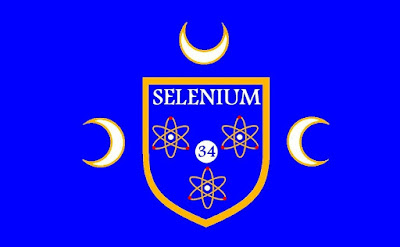Translate
Thursday, February 9, 2017
English French Mixed Heritage Flag
The French-English Fusion flag is for events and persons who are mixed English and French. Usually an intense rivalry for most as is the case with Korea and Japan, but many times great love and harmony and love can exist between the English and French. In this case persons who are mixed up with both English and French heritages genetic or not can fly this flag of love.
Fun Flag for Helium, Element Number 2
The Fun Flag for Helium is based upon a combination of the English and French Flags. The English Red Cross takes center stage while the background colours of France are recessive. In the center is a shield with the symbol of the Sun which also acts as an element of Helium with two electrons.
Helion, or rather Helium, was first noticed as a separate element by a Frenchman in India, Jules Janssen, but it was an Englishman, Norman Lockyer, who first to gave it a name, and both events coincidentally by providence took place in 1868. Lockyer named this element after the Sun God from the Greeks, Helios.
Fun Flag for Selenium, Element 34
 The Fun Flag for Selenium is based upon the Swedish national coat of arms. Instead of three golden crowns we have three golden atoms, and instead of red rubies we have red electrons. The symbol of the moon is in the crest position and the colours of Sweden are shown, blue and yellow.
The Fun Flag for Selenium is based upon the Swedish national coat of arms. Instead of three golden crowns we have three golden atoms, and instead of red rubies we have red electrons. The symbol of the moon is in the crest position and the colours of Sweden are shown, blue and yellow.The Fun Selenium flag has a moon upon it since it's namesake is the Greek for the Goddess of the Moon- Selene.
Fun Flag for Element 52, Tellurium
 The Fun Flag for Tellurium is based upon the flag of Romania, since this element was discovered there, during its Austrian Hapsburg phase. Likewise the central coat of arms are black and yellow which are related to the Austrian Hapsburg Era colours.
The Fun Flag for Tellurium is based upon the flag of Romania, since this element was discovered there, during its Austrian Hapsburg phase. Likewise the central coat of arms are black and yellow which are related to the Austrian Hapsburg Era colours.Also note since Tellurium is named after the planet Earth, we have the symbol of Earth in the center with two atoms up top and its atomic Z number on the lower portion. Like a proper set deck of cards, Tellurium is Oxygen's second cousin, leaning towards the transgendered element, being both masculine metal and feminine organic-wood.
Coincidentally the pattern of Romania is repeated in Africa with the nation of Chad and two more times in Europe with Andorra and Moldova. The Earth symbol by synchronicity reflects four different corners of the Earth that carry the "Romanian-Earth" colours: Romania, Chad, Moldova, and Andorra. They are so many unused national flag patterns, like they could have modified the order or use a different pattern? Nope, it was by fate that these four nations would use the blue, yellow, red vertical tribar, how graceful now, considering the genesis of the Fun Tellurium Flag.
Tuesday, February 7, 2017
Fun Flag for Copper
The Fun Copper Flag is based upon the flags of Cyprus, which is where the word copper is derived from. The copper and green colours are based upon the flag of modern day Cyprus, as is the olive branch. Likewise the lions are based upon the old British colonial ensign. Finally red is also taken from the Northern Cyprus flag as well.
The three lions symbolize that this element was known to the ancients, as it was in Africa, Asia, and Europe before the rise of the Roman Empire or Great Walls of China. Under the green lion is the Egyptian word for Copper, under the red lion is the Chinese word for copper, and finally under the copper lion is the English word for Copper. Just above the olive branches is the atomic Z number for copper, 29.
Monday, February 6, 2017
Fun Flag for Manganese, Element 25
The Fun Flag for Manganese combines the colours of Sweden and Greece. This element was articulated in scientific detail by a Swedish person, but it gets its namesake from the region of Greece known as Magnesia. Also note that Magnesium-Element 12 is also named after this special region of Greece.
Sunday, February 5, 2017
Fun Hafnium Flag - Element 72
The Fun Hafnium Flag combines the flags of Denmark, the Netherlands, and Hungary. Reason being this element was discovered in Copenhagen, Denmark in 1922 by a scientist from the Netherlands, Dirk Coster, and another from Hungary, Georg von Hevesy.
Hafnium gets its name from the Latin name of Copenhagen, consequently the Danish banner makes up "Haff of the Hafnium" Flag. Coincidentally the flags of the Netherlands can be seen on the fly side, while the Hungarian flag is on the left.
Note that Hafnium is the Latin name for Copenhagen and this element will soon turn 100 in 2022.
Subscribe to:
Comments (Atom)









